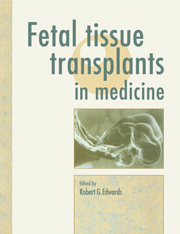Book contents
- Frontmatter
- Contents
- List of contributors
- Preface
- 1 Differentiation and transplantation of embryonic cells in mammals
- 2 Organogenesis and central nervous system development
- 3 Experimental human hematopoiesis in immunodeficient SCID mice engrafted with fetal blood-forming organs
- 4 Ontogeny of human T- and B-cell immunity
- 5 The procurement of human fetal tissues for clinical transplantation. Practice and problems
- 6 Transplantation of fetal haemopoietic and lymphopoietic cells in humans, with special reference to in utero transplantation
- 7 The biology of fetal brain tissue grafts: from mouse to man
- 8 Clinical results of transplanting fetal pancreas
- 9 The suitability of fetal and infantile donors for corneal transplantation
- 10 Transplantation of ovaries and testes
- 11 Cell grafting and gene therapy in metabolic diseases
- 12 The low temperature preservation of fetal cells
- 13 Law and ethics of transplanting fetal tissue
- Appendix: Code of practice on the use of fetuses and fetal material in research and treatment
- Brief bibliography on various aspects of transplanting fetal 337 tissue
- Index
7 - The biology of fetal brain tissue grafts: from mouse to man
- Frontmatter
- Contents
- List of contributors
- Preface
- 1 Differentiation and transplantation of embryonic cells in mammals
- 2 Organogenesis and central nervous system development
- 3 Experimental human hematopoiesis in immunodeficient SCID mice engrafted with fetal blood-forming organs
- 4 Ontogeny of human T- and B-cell immunity
- 5 The procurement of human fetal tissues for clinical transplantation. Practice and problems
- 6 Transplantation of fetal haemopoietic and lymphopoietic cells in humans, with special reference to in utero transplantation
- 7 The biology of fetal brain tissue grafts: from mouse to man
- 8 Clinical results of transplanting fetal pancreas
- 9 The suitability of fetal and infantile donors for corneal transplantation
- 10 Transplantation of ovaries and testes
- 11 Cell grafting and gene therapy in metabolic diseases
- 12 The low temperature preservation of fetal cells
- 13 Law and ethics of transplanting fetal tissue
- Appendix: Code of practice on the use of fetuses and fetal material in research and treatment
- Brief bibliography on various aspects of transplanting fetal 337 tissue
- Index
Summary
NEURAL TRANSPLANTATION TO THE MAMMALIAN BRAIN is a field of long-standing interest to neuroscientists. Since the first reports on cortex or spinal cord grafting experiments around the turn of the century (Thompson, 1890; Shirres, 1905), the demonstration that immature brain tissue can survive (Dunn, 1917) and differentiate (Le Gros Clarke, 1940) in the adult host brain form milestones on the way to a more widespread application of neural grafting techniques since the early- and mid-seventies (Das & Altman, 1971). The finding that grafts of fetal ventral mesencephalic tissue, rich in dopamine (DA) neurons, can reverse lesion-induced functional deficits in an animal model of Parkinson's disease (Bjorklund & Stenevi, 1979; Perlow et al., 1979) has led to increased interest in neural transplantation in a wide variety of animal models of neurodegenerative diseases and other forms of neuronal or neuroendocrine dysfunction. Neural transplants of fetal brain tissue have since been investigated in animal models of Huntington's chorea (Deckel et al, 1983; Isacson et al, 1986); Alzheimer's disease (Dunnett, 1990); hypogonadotropic hypogonadism (Krieger et al, 1982; Gibson et al, 1984); diabetes insipidus (Gash & Sladek, 1984); epilepsy (Barry et al, 1987); demyelinating diseases (Lachapelle et al, 1984); cerebellar ataxia (Sotelo & Alvarado- Mallart, 1986); callosal agenesis (Smith et al, 1987); spinal cord injury (Nygrene et al., 1977; Nornes et al., 1983;Reier, 1985); cerebral ischemia and stroke (Mudrick et al., 1988; Tonder et al, 1989; Onifer & Low, 1990); cortical hypoplasia (Lee & Rabe, 1988, 1990); drug-induced prenatal brain damage (Yanai & Pick, 1988); and retinal degeneration (Turner & Blair, 1986).
The unique experimental situation created by grafting fetal brain tissue to the adult host brain has posed many fascinating questions. Which developmental characteristics does immature neural tissue display in a differentiated environment? How does the adult host brain react to the grafted immature tissue? Does this represent an unnatural situation where abnormal development and interaction occurs or may it allow for insights into the mechanisms governing neural differentiation, plasticity and regeneration? As has gradually emerged over the last fifteen years, the developmental potential of different fetal CNS tissues grafted to the adult brain is governed - at least in part - by several basic principles.
- Type
- Chapter
- Information
- Fetal Tissue Transplants in Medicine , pp. 177 - 214Publisher: Cambridge University PressPrint publication year: 1992



